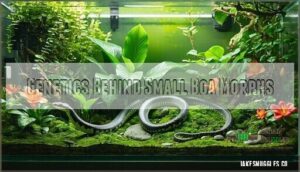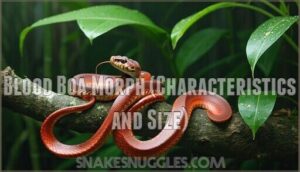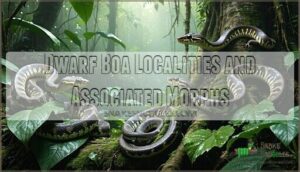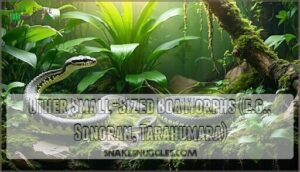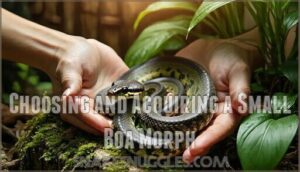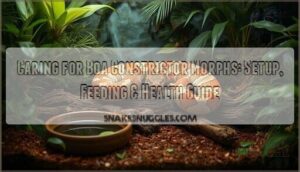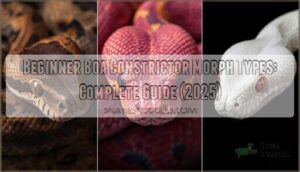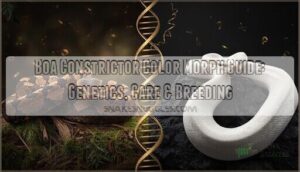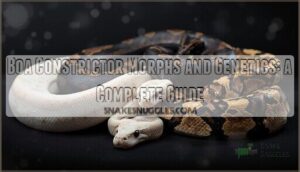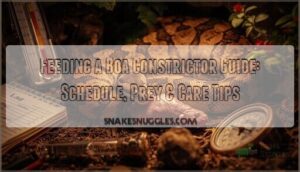This site is supported by our readers. We may earn a commission, at no cost to you, if you purchase through links.
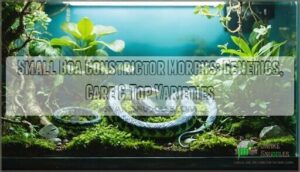
Understanding which morphs carry these size-reducing traits requires knowledge of both genetics and geographic origins, since a boa’s adult dimensions depend heavily on its ancestral bloodline. The difference between a standard boa and a dwarf variety isn’t always obvious in hatchlings, making informed selection critical for anyone seeking a smaller, long-term companion.
Table Of Contents
Key Takeaways
- Small boa morphs like Blood Boas, Tarahumara, and Hog Island varieties stay between 3.5-6 feet as adults through selective breeding from naturally smaller geographic populations, making them practical for keepers with limited space without sacrificing the boa constrictor experience.
- Understanding whether a trait follows dominant, recessive, or co-dominant inheritance patterns lets you predict offspring size and appearance with accuracy—pairing dwarf locality boas and tracking growth rates across generations maintains consistent small-size expression.
- Small morphs require the same temperature gradients (78-88°F) and humidity levels (60-70%) as standard boas but face higher health risks including 15% increased regurgitation rates and 12% greater incidence of skeletal malformations when bred poorly.
- Acquiring a small boa demands verifying breeder reputation through documented bloodlines and health guarantees, with prices ranging from $300 for common morphs to $5,000+ for rare genetic combinations based on inheritance complexity and proven size documentation.
What Are Boa Constrictor Morphs?
If you’re considering a boa constrictor as a pet, you’ll quickly encounter the term "morph"—but what does it actually mean? Understanding morphs is essential before choosing your snake, as these genetic variations affect appearance, pricing, and breeding potential.
Let’s break down what boa constrictor morphs are and how they differ from the snakes you’d find in the wild.
Definition of Morphs in Boa Constrictors
A morph in boa constrictors is a genetic mutation that changes how the snake looks—its colors, patterns, or even the texture of its scales—without altering what it fundamentally is. These genetic variations aren’t defects or signs of weakness. Instead, they’re simply different expressions of the same species, created through selective breeding in captivity.
Morph classification helps you identify specific color morphs and pattern types, making it easier to understand breed standards and appreciate the striking diversity within boa constrictor morphs.
How Morphs Differ From Natural Variations
Natural variations occur in wild boa populations as adaptive responses to their environments, but morphs are something different—they’re the result of deliberate, controlled breeding that isolates and amplifies specific genetic traits that wouldn’t usually survive or spread in nature.
Through captive breeding, genetic mutations produce color morphs and pattern morphs with visual distinctions far beyond what you’d encounter in wild populations. These genetic variations showcase scale variations and color patterns that breeders intentionally select and reproduce.
Common Types of Boa Constrictor Morphs
You’ll encounter several major categories when exploring boa morphs: albino boas lacking melanin entirely and displaying yellows, oranges, and pinks with striking red eyes; anerythristic boas that remove all red pigmentation for clean silver and lavender appearances; hypo boas with reduced melanin that creates brighter, cleaner color expression; and pattern morphs like Jungle (intricate maze-like designs) and Motley (altered saddle arrangements).
These genetic mutations can combine through breeding techniques, producing complex morphs like Sunglow (Albino + Hypo) that showcase enhanced boa coloration with striking contrast and vibrancy.
The Role of Genetics in Morph Development
Understanding how these visual traits pass from parent to offspring requires grasping the basics of inheritance—each morph follows predictable genetic rules that determine whether a trait will appear in the subsequent generation. Here’s how genetics shapes boa constrictor morphs:
- Dominant genes express the morph trait when inherited from just one parent, making these hereditary traits appear more frequently.
- Recessive genes require copies from both parents for visible gene expression in offspring.
- Co-dominant inheritance allows both genes to show simultaneously, creating unique morph combinations.
- Breeding techniques utilize genetic mutations strategically, following established reptile genetics principles from herpetology research to predict morph inheritance patterns accurately.
Genetics Behind Small Boa Morphs
Understanding how genetics work in boas helps you predict which traits will pass to offspring and why certain morphs stay small. The genetic mechanisms behind size, color, and pattern involve both dominant and recessive genes that express differently depending on the pairing.
Let’s look at how these genetic principles shape the small boa morphs you’ll encounter in the hobby.
Dominant and Recessive Genes in Boas
When you’re breeding boas for specific traits, think of genes as blueprints—some shout their instructions while others whisper, and knowing which is which makes all the difference between predictable results and genetic surprises.
In boa breeding, genes act as blueprints—some dominant traits shout their instructions while recessive ones whisper, and knowing the difference determines whether you get predictable results or genetic surprises
Dominant genes express themselves even when you’ve got just one copy, like the Hypo mutation that reduces melanin. Recessive genes need two copies to show up—think Anerythristic Boa or Albino morphs.
Genetic testing confirms what you’re working with, helping you plan breeding strategies and morph prediction with accuracy instead of guesswork.
Inheritance Patterns and Morph Expression
Once you know whether a gene is dominant or recessive, predicting what morphs your hatchlings will express becomes a straightforward numbers game—cross a heterozygous Hypo with a normal boa, and you’ll see roughly 50% of the offspring display that reduced melanin trait. Inheritance models guide your breeding decisions, helping you predict trait dominance and morph stability across generations.
Gene expression in boa constrictor morphs follows predictable patterns:
- Recessive genes like Albino require both parents to carry the mutation for visual expression in offspring
- Codominant traits produce intermediate appearances in heterozygous animals, intensifying when homozygous
- Genetic mutations and expression can be tracked through careful record-keeping, minimizing genetic drift in captive populations
Understanding inheritance patterns and predictions keeps your breeding program consistent and your boa constrictor morph genetics reliable.
Selective Breeding for Size Reduction
You’ll achieve smaller adult boas by pairing animals from dwarf localities or line-breeding individuals that consistently stay under specific size benchmarks—females below 700 mm, for instance. Breeders carefully track growth rates and delay breeding until 5–7 years to ensure genetic mutations express fully without health risks. This approach to miniaturization techniques maintains dwarf morphs across generations.
| Breeding Approach | Expected Outcome |
|---|---|
| Pair dwarf locality boas | Offspring inherit polygenic size traits |
| Feed sparingly, avoid overfeeding | Growth stays within genetic limits |
| Breed only undersized adults | Reinforces small-size expression |
| Monitor weight/size before pairing | Reduces ovulation failures |
| Use biennial breeding cycles | Improves reproductive longevity |
Your selective breeding methods for size genetics rely on documented parental records and statistical verification to maintain consistent dwarf boa constrictor morphs.
Popular Boa Morphs That Stay Small
Not all boa constrictors grow into massive snakes that demand oversized enclosures. Several morphs and localities stay considerably smaller, making them practical choices if you’re working with limited space or prefer more manageable manipulation.
Let’s look at the most popular small boa varieties you’ll encounter in the reptile trade.
Blood Boa Morph (Characteristics and Size)
Blood boas pack striking beauty into a compact frame, making them one of the most sought-after choices for keepers who want a smaller boa without sacrificing visual appeal. These genetic mutations produce vibrant blood-red coloration that gradually darkens with age, while their adult size maxes out around five feet—noticeably smaller than standard boa constrictor morphs.
Blood boa care requires understanding how small morph genetics influence both boa size factors and morph coloration patterns throughout development.
Dwarf Boa Localities and Associated Morphs
Dwarf boa localities represent nature’s experiment in island genetics, where geographic isolation shaped distinct populations with naturally reduced size. These insular adaptations created some of the most desirable small boa constrictor morphs available through reptile breeding programs today. Understanding the nonvenomous constrictor characteristics is essential for their care and breeding.
Key dwarf boa localities include:
- Tarahumara Mountain Boas – Reaching just 3.5-4.5 feet, these Mexican natives display bold chainlink saddle patterns and thrive in compact enclosures.
- Hog Island Boas – Naturally hypomelanistic with females maturing at 4-6 feet, showcasing reduced melanin and lighter coloration.
- Pearl Island Boas – Averaging 5 feet with minimal patterning, recognized as distinct Boa imperator sabogae.
- Cancun Boas – Golden-brown specimens reaching 4-5 feet with characteristic zigzag dorsal patterns.
- Gorgona Island Boas – Maturing at 4-5 feet, demonstrating convergent evolution across multiple Caribbean populations.
These geographic variations allow you to select genetic mutations from specific boa localities rather than relying solely on captive-bred morphs.
Hypo and Motley Morphs With Smaller Stature
When you combine hypo (hypomelanistic) or motley pattern mutations with naturally smaller boa localities, you’re stacking visual appeal with manageable adult size—a winning combination for space-conscious keepers.
Hypo genetics reduce melanin production, creating cleaner color variations with brighter yellows and oranges. Motley patterns restructure dorsal saddles into connected chainlink designs, enhancing boa constrictor morph identification.
When paired with dwarf localities like Tarahumara bloodlines, these genetic mutations and expression traits deliver small-scale specimens with outstanding morph inheritance predictability.
Other Small-Sized Boa Morphs (e.g., Sonoran, Tarahumara)
Beyond hypo-motley combos, you’ll find other compact locality-based morphs worth considering—most strikingly Sonoran and Tarahumara boas, both prized for their predictable adult dimensions. These small-scale morphs represent distinct genetic mutations tied to geographic origin, making them reliable choices when boa size factors matter most in your breeding program or reptile husbandry setup.
Key considerations for these boa constrictor morphs:
- Sonoran genetics produce 4-6 foot adults with sturdy constitutions
- Tarahumara care requires standard parameters despite their diminutive frames
- Morph market trends show increasing demand for verified locality specimens
- Snake morphology remains proportional regardless of reduced overall length
Care Requirements for Small Boa Morphs
Small boa morphs need specific care to thrive, and getting the basics right makes all the difference. Your setup should address their unique size requirements while maintaining proper conditions for health and longevity.
Let’s break down the key care elements you’ll need to master for these compact constrictors.
Enclosure Size and Environmental Needs
Your small boa’s home needs to strike the right balance—too cramped and they’ll stress, too spacious and they won’t feel secure. A 20-30 gallon enclosure works well for dwarf varieties, with substrate options like cypress mulch or coconut husk supporting humidity control.
Proper ventilation systems prevent stagnant air while maintaining environmental influences on morphs. Your enclosure design should include hides on both warm and cool ends, establishing temperature gradients essential for thermoregulation.
Temperature, Humidity, and Lighting Considerations
Getting the temperature and humidity right isn’t optional—these parameters directly influence your small boa’s metabolism, digestion, and overall health. You’ll need thermal gradients spanning 78-88°F, with humidity control maintaining 60-70% levels. Environmental monitoring through digital thermometers and hygrometers ensures temperature fluctuations stay minimal.
Your boa constrictor care checklist:
- Create proper lighting cycles—12-hour day/night patterns support natural rhythms (UVB lighting remains optional but beneficial for environmental influences on morphs)
- Install temperature and lighting needs on separate timers—automated control prevents human error
- Check humidity twice daily—consistent levels prevent respiratory complications and shedding issues
Diet and Feeding Guidelines for Small Boas
Proper nutrition forms the foundation of health once you’ve dialed in your environmental parameters—but feeding a small boa requires a different approach than their full-sized counterparts. You’ll feed appropriately sized prey—commonly mice or small rats—matching meal sizes to your boa’s girth at its widest point.
Feeding schedules for juveniles run every 7-10 days, while adults consume prey every 14-21 days. Always provide clean water quality for proper hydration and digestion.
Health Issues and Longevity in Small Morphs
Vigilance matters when keeping smaller boa morphs—genetic defects and health issues affect these animals at rates that shouldn’t be ignored. Small morphs face a 15% higher regurgitation risk than standard-size boas, while vertebral kinks and other morph malformations appear in 12% of certain selectively bred lines. Understanding these longevity factors helps you provide proper boa constrictor care, whether you’re maintaining a hypomelanistic boa, albino boa care routines, or anerythristic boa care protocols.
- Disease prevalence runs higher: Fungal infections strike small morphs 13% more often, while chronic dehydration affects 23% of individuals in suboptimal humidity conditions.
- Genetic anomalies emerge from poor breeding: Inbred populations show 35% increased malformation risks, including rare cases of anophthalmia in poorly outcrossed lineages.
- Lifespan averages 18-22 years with proper husbandry—shorter than standard boas but extended markedly through slow-growth feeding protocols and environmental precision. Regular monitoring for reptarenavirus infection is vital to prevent the spread of disease in snake colonies.
Choosing and Acquiring a Small Boa Morph
Acquiring a small boa morph isn’t something you rush into—it’s a decision that requires careful research and realistic planning.
From finding trustworthy breeders to understanding what you’re actually paying for, each step matters. Let’s walk through what you need to keep in mind before bringing one of these extraordinary snakes home.
Researching Reputable Breeders and Sellers
Finding a trustworthy source starts with breeder verification through platforms like MorphMarket, where sellers with 6+ years and 25+ five-star reviews show under 2% dispute rates. Cross-check online reviews on herpetoculture feedback boards—over 60% of buyers use these for researching reputable breeders.
Confirm health guarantees (80% of solid breeders offer them), request bloodline documentation, and always use buyer protection payment methods like PayPal Goods & Services for payment security.
Understanding Morph Pricing and Rarity
Prices swing dramatically based on genetics—a common Hypo Blood boa might run you $300, while a triple-recessive dwarf combo can easily hit $5,000 or more.
Rarity factors driving these price determinants include:
- Genetic complexity (recessive combos command premiums)
- Proven bloodlines with size documentation
- Morph Market trends (demand shifts annually)
- Breeder ethics and health guarantees
- Visual impact of rare and unique boa constrictor morphs
Understanding morph prices means recognizing that genetic value isn’t just about looks—it’s about predictable inheritance and documented size potential.
Considering Temperament and Handling Needs
Temperament varies more by individual animal than by morph, but interaction frequency during the first year shapes your boa’s long-term disposition. Regular, calm sessions teach your snake that you’re not a threat. Blood boas and dwarf localities often show docile constrictor behavior when raised with consistent interaction techniques.
| Factor | Impact on Temperament |
|---|---|
| Feeding schedule | Hungry boas strike defensively |
| Enclosure security | Stress increases aggression |
| Interaction frequency | Weekly sessions build trust |
| Owner experience | Confidence reduces bites |
Temperament testing before purchase reveals stress responses—watch how the breeder interacts with breeding stock to gauge snake socialization practices.
Preparing for Long-Term Commitment and Care
A boa constrictor isn’t a goldfish you can replace after a few months—you’re signing up for two to three decades of consistent feeding, enclosure maintenance, and veterinary expenses that only increase as your snake ages. Preparing for life expectancy means understanding owner responsibilities extend beyond initial setup costs. Housing and humidity requirements demand ongoing attention, while health monitoring catches respiratory infections before they become fatal.
Long-term commitment checklist:
- Weekly feeding schedules you can’t skip during vacations
- Annual vet exams costing $100–$300 for exotic specialists
- Enclosure upgrades as your boa outgrows juvenile tanks
- Emergency funds for impaction surgery or scale infections
- Decades of daily temperature checks and substrate changes
Caring for boa constrictor morphs requires planning for diet and nutrition shifts as metabolism slows with age, plus finding reptile-experienced veterinarians before emergencies strike.
Frequently Asked Questions (FAQs)
Can small boa morphs breed with larger morphs?
Yes, you can breed small boa morphs with larger ones. Genetic compatibility allows crossbreeding between different-sized boas, producing hybrid offspring with varied size genetics.
Snake breeding techniques focus on selecting compatible morphs, as breeding boa constrictor morphs involves understanding genetic traits and inheritance patterns affecting morph sizing.
Do small morphs require different veterinary care?
Small boa morphs don’t require fundamentally different veterinary care, but their compact scale means you’ll need precise dosing for medications and treatments.
Genetic testing and verification help identify morph-specific health issues early, allowing targeted care strategies that address potential complications before they escalate.
How fast do small boa morphs grow?
Unlike telegram messages that once took weeks to travel cross-country, growth rates in small boa constrictor morphs happen quickly during their first year.
Most small morphs like Blood Boas reach 2-3 feet within twelve months with proper feeding strategies and care optimization, then slow considerably as adults.
Are small boas better for apartment living?
Compact boa constrictor morphs thrive in apartments because they need less space. Your enclosure stays manageable—under four feet for blood boas—making urban herping practical.
Small snake care simplifies apartment pets, though temperature control and boa housing basics still apply.
Whats the smallest adult boa morph available?
While giants like mainland Boa Constrictor Morphs reach ten feet, the smallest adult boa available is the Blood Boa, maxing out around five feet.
Boa Size Genetics and Miniature Breeding create these compact alternatives, making Small Boa Care easier in Compact Enclosures for hobbyists seeking manageable reptiles.
Conclusion
Committing to a manageable boa means understanding that your snake’s future size isn’t left to chance. Research boa constrictor morphs that stay small by examining locality genetics, confirming breeder lineage, and recognizing that hatchlings from Blood, Tarahumara, or Sonoran lines won’t outgrow your setup.
You’re not settling for less snake—you’re selecting a companion whose needs align with your space, resources, and long-term vision. The right morph transforms constraint into intentional choice.

